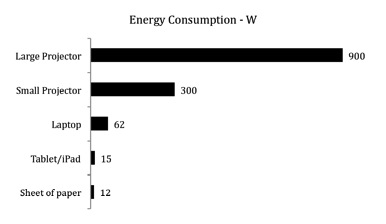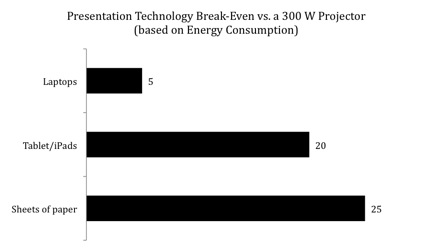In my workshops, participants sometimes raise the concern that Conference Room Style presentations use paper handouts, and that this is harmful for the environment. In order to help understand the tradeoffs, I decided to investigate the environmental implications of some presentation technology options. To simplify
the analysis, I focused only on the energy consumption of each technology—the energy required to produce the paper and to run the various electronic devices (i.e. projector, laptop, tablet/iPad). I ignored the cost of producing and then disposing of the electronic devices.
It turns out that it costs approximately 12 Watt/hours of energy to create one sheet of paper (for 100% recycled paper; non-recycled paper requires more energy). Tablets/iPads consume 15 W of energy while
laptops consume 62 W. Projector energy consumption varies depending on power; a smaller conference room projector might consume 300 W; a larger hotel ballroom projector, say 900 W.
These figures allow us to compute a rudimentary “break-even” analysis. If you were deciding on environmental (i.e. energy consumption) factors alone, is it more energy efficient to (a) to use a small projector, (b) have the audiencefollow along on their laptops or tablets, or (c) provide handouts? By dividing the wattage of the projector bythose of the alternatives, we get the following break-even figures:
This means that if you expect to have an audience size of more than five following your presentation on their laptops, it would be more energy efficient to use a projector. However, an audience size of up to 20
following along on tablets/iPads would be more energy efficient than using a projector. And as for paper, anything more than 25 sheets in total (e.g. five audience members with a five-page deck, or 25 with a 1-pager, etc.) makes the projector more attractive in energy consumption terms.
The equivalent figures for a larger, 900 W projector are 15 laptops, 60 tablets, or 75 sheets of paper. Since larger projectors are usually used with audience sizes in the hundreds, it would seem that for such sized groups, the projector is always the most energy-efficient option.
The purpose of this post is not to suggest that energy consumption should be the only criterion for deciding which presentation technology to use. My point, rather, is to suggest that paper is not necessarily always the least environmentally friendly presentation option. For smaller groups, and shorter decks (shorter decks are a better choice for so many other reasons also!), paper would seem to be a reasonable choice.

